(新课标)Unit 4 Don't eat in class. Section A Grammar focus-3c 语法课示范课课件(共35张)
文档属性
| 名称 | (新课标)Unit 4 Don't eat in class. Section A Grammar focus-3c 语法课示范课课件(共35张) |  | |
| 格式 | zip | ||
| 文件大小 | 7.4MB | ||
| 资源类型 | 试卷 | ||
| 版本资源 | 人教新目标(Go for it)版 | ||
| 科目 | 英语 | ||
| 更新时间 | 2023-03-03 10:28:55 | ||
图片预览

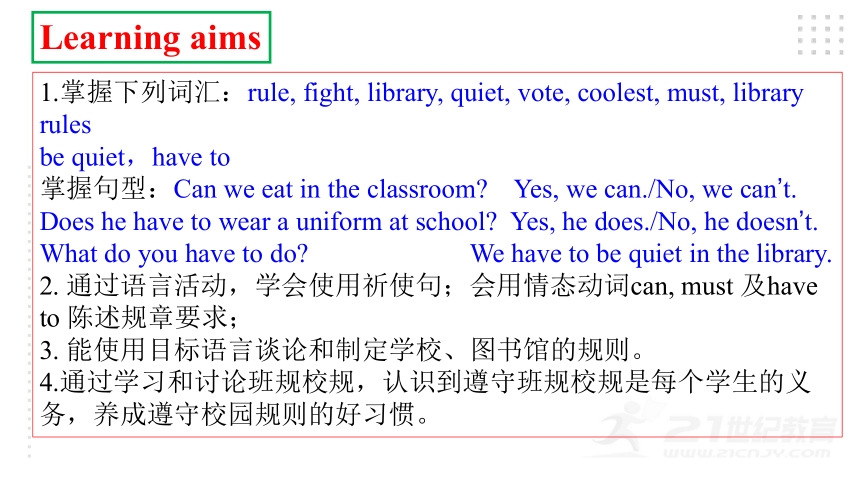
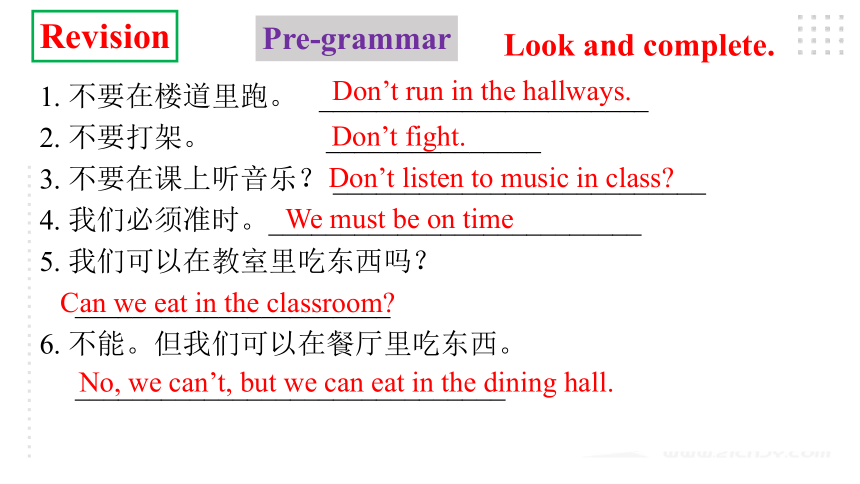
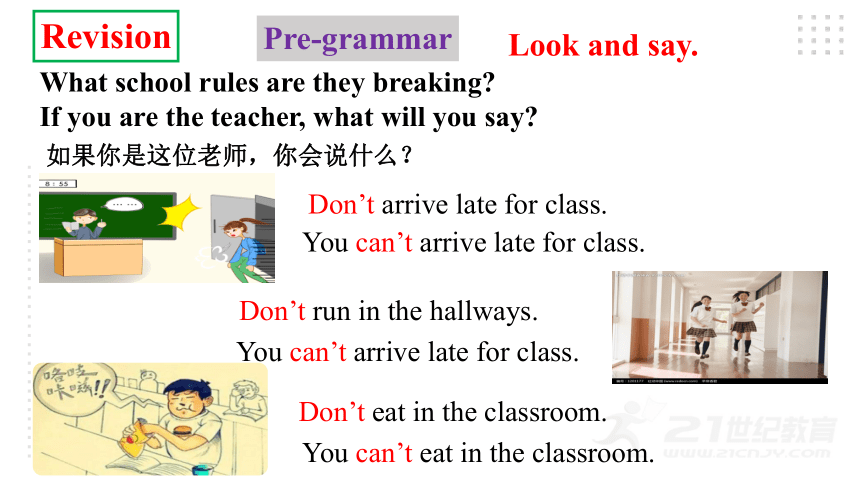
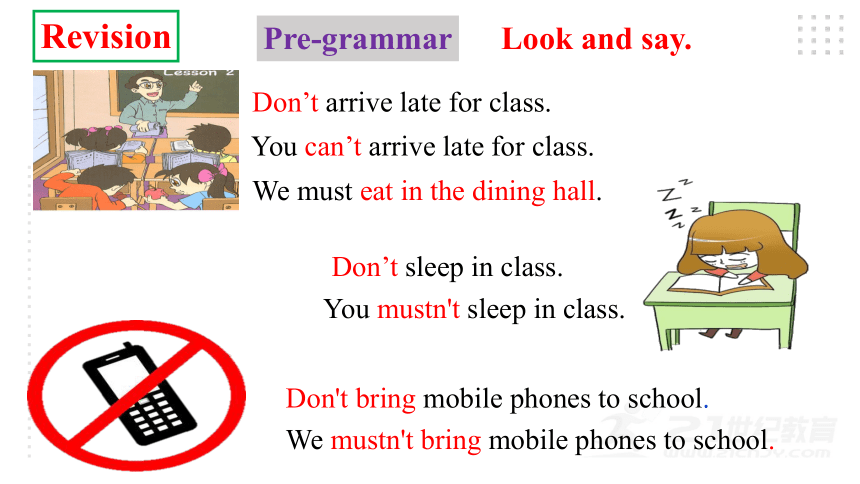
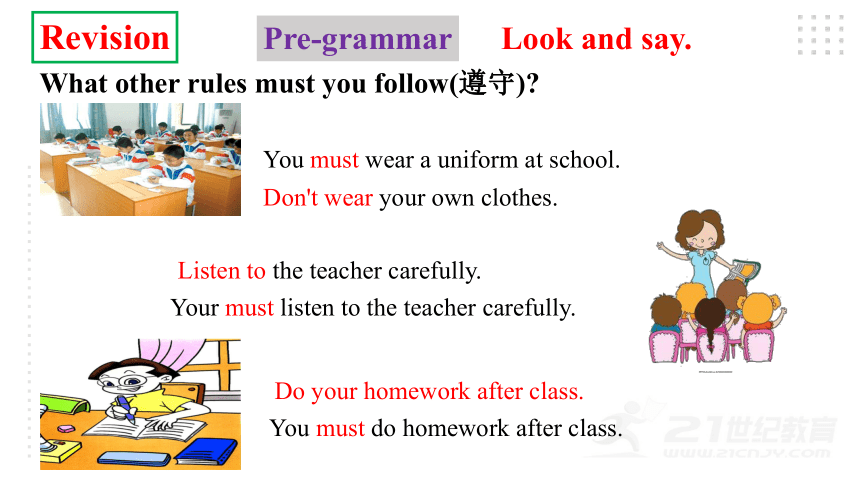
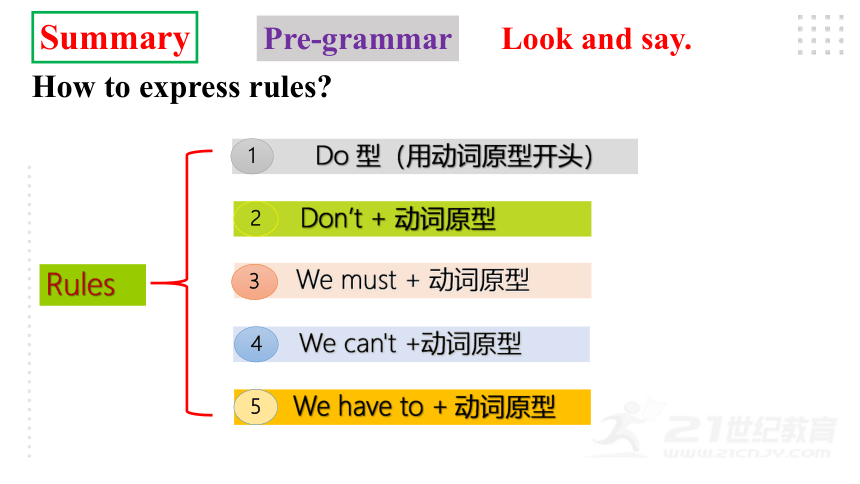
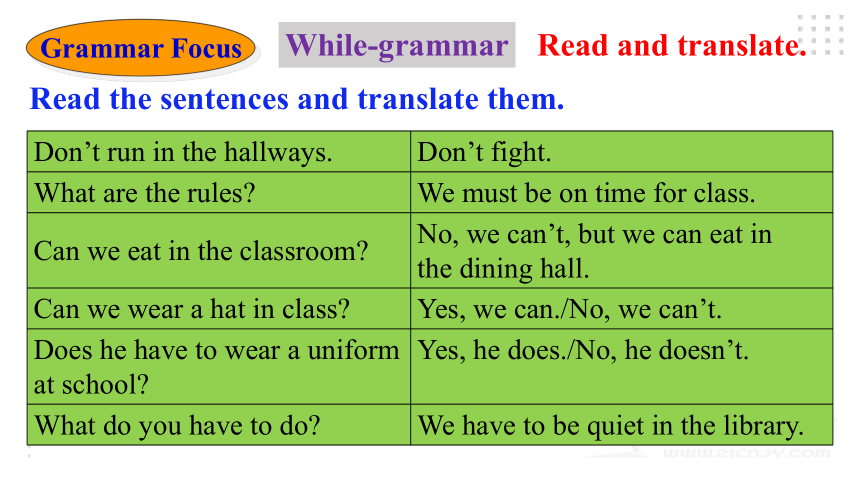

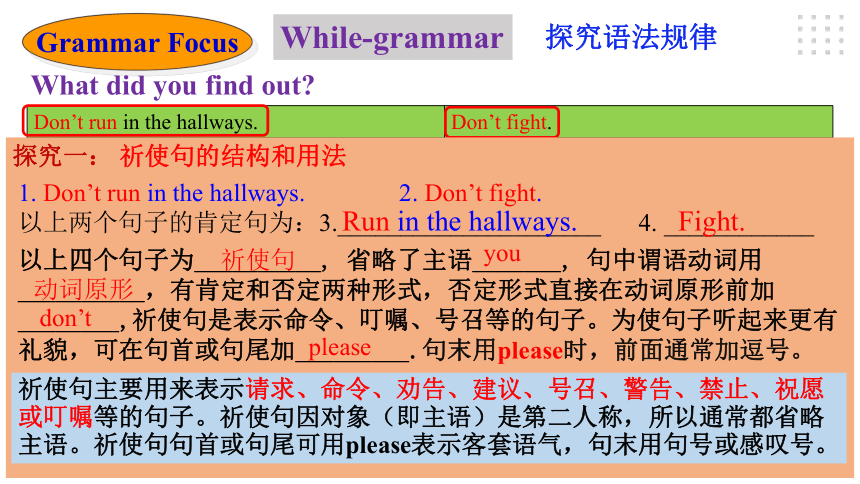
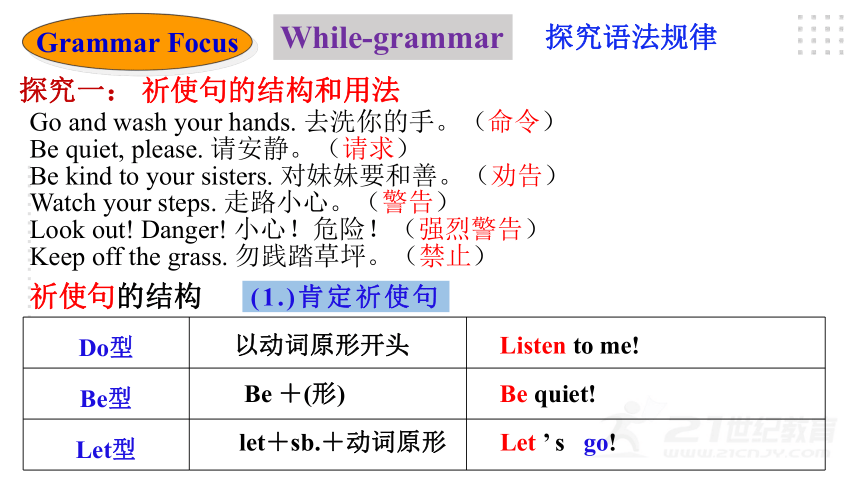
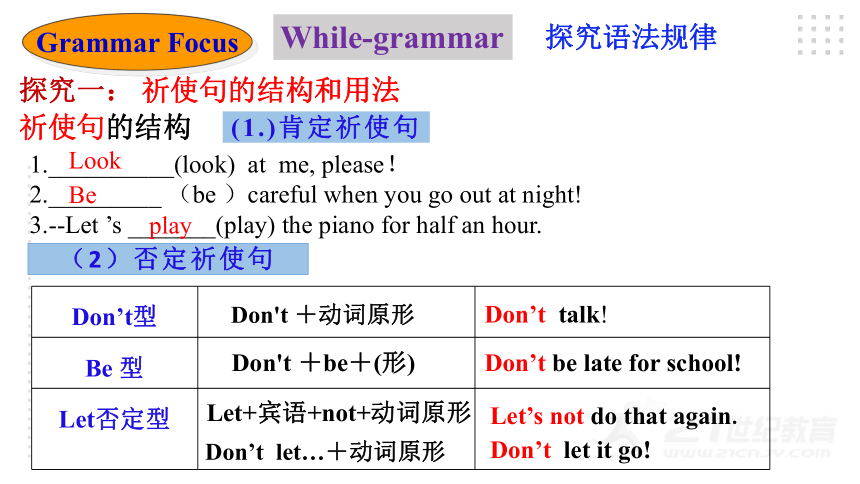
文档简介
(共35张PPT)
人教新目标版 七年级(下)
Unit 4 Don't eat in class.
Period 2 Section A
Grammar focus-3c
听说课示范课
Presentation
Learning aims
1.掌握下列词汇:rule, fight, library, quiet, vote, coolest, must, library rules
be quiet,have to
掌握句型:Can we eat in the classroom Yes, we can./No, we can’t.
Does he have to wear a uniform at school Yes, he does./No, he doesn’t.
What do you have to do We have to be quiet in the library.
2. 通过语言活动,学会使用祈使句;会用情态动词can, must 及have to 陈述规章要求;
3. 能使用目标语言谈论和制定学校、图书馆的规则。
4.通过学习和讨论班规校规,认识到遵守班规校规是每个学生的义务,养成遵守校园规则的好习惯。
Presentation
Revision
Pre-grammar
Look and complete.
1. 不要在楼道里跑。 _______________________
2. 不要打架。 _______________
3. 不要在课上听音乐? __________________________
4. 我们必须准时。__________________________
5. 我们可以在教室里吃东西吗?
______________________
6. 不能。但我们可以在餐厅里吃东西。
______________________________
Don’t fight.
Don’t run in the hallways.
Don’t listen to music in class
We must be on time
Can we eat in the classroom
No, we can’t, but we can eat in the dining hall.
Presentation
Revision
Pre-grammar
Look and say.
What school rules are they breaking
If you are the teacher, what will you say
如果你是这位老师,你会说什么?
Don’t arrive late for class.
You can’t arrive late for class.
Don’t run in the hallways.
You can’t arrive late for class.
Don’t eat in the classroom.
You can’t eat in the classroom.
Presentation
Revision
Pre-grammar
Look and say.
Don’t arrive late for class.
You can’t arrive late for class.
We must eat in the dining hall.
Don’t sleep in class.
You mustn't sleep in class.
We mustn't bring mobile phones to school.
Don't bring mobile phones to school.
Presentation
Revision
Pre-grammar
Look and say.
What other rules must you follow(遵守)
You must wear a uniform at school.
Don't wear your own clothes.
Listen to the teacher carefully.
Your must listen to the teacher carefully.
You must do homework after class.
Do your homework after class.
Presentation
Summary
Pre-grammar
Look and say.
How to express rules
Do 型(用动词原型开头)
1
Don’t + 动词原型
2
We must + 动词原型
3
We can't +动词原型
4
We have to + 动词原型
5
Rules
Presentation
Don’t run in the hallways. Don’t fight.
What are the rules We must be on time for class.
Can we eat in the classroom No, we can’t, but we can eat in
the dining hall.
Can we wear a hat in class Yes, we can./No, we can’t.
Does he have to wear a uniform
at school Yes, he does./No, he doesn’t.
What do you have to do We have to be quiet in the library.
Read the sentences and translate them.
Grammar Focus
While-grammar
Read and translate.
Presentation
Practice
While-grammar
Read and translate.
Fill in the blanks according to grammar focus.
1. 不要在楼道里跑。 ______ _______in the hallways.
2. 不要打架。 ______ _______.
3. 有什么规则? What ______the _______
4. 我们必须按时上课. We _____ _____on time for class.
5. 我们可以在教室里吃东西吗?_______we _____in the classroom
6. 不能。但我们可以在餐厅里吃东西。
No, we can’t, but we ____ ____in the dining hall.
7. 我们可以在上课的时候带帽子吗?______ we _____a hat in class
8. 他在学校里必须穿校服吗? ____ he ____ ___ ____a uniform at school
9. 是的,必须。/ 不,不必。 Yes, he does. / No, he doesn’t.
10. 你们必须做什么 What _____ you_____ ____ _____
11. 在图书馆里我们必须保持安静。We have to ____ _____in the library.
Don’t run
Don’t fight
are
rules
must be
Can
eat
can eat
Can
wear
Does
have to wear
do
have to do
be quiet
Presentation
While-grammar
Don’t run in the hallways. Don’t fight.
What are the rules We must be on time for class.
Can we eat in the classroom No, we can’t, but we can eat in
the dining hall.
Can we wear a hat in class Yes, we can./No, we can’t.
Does he have to wear a uniform at school Yes, he does./No, he doesn’t.
What do you have to do We have to be quiet in the library.
探究语法规律
What did you find out
探究一: 祈使句的结构和用法
1. Don’t run in the hallways. 2. Don’t fight.
以上两个句子的肯定句为:3._____________________ 4. ____________
Run in the hallways.
Fight.
以上四个句子为__________, 省略了主语_______, 句中谓语动词用__________,有肯定和否定两种形式,否定形式直接在动词原形前加________,祈使句是表示命令、叮嘱、号召等的句子。为使句子听起来更有
礼貌,可在句首或句尾加_________.句末用please时,前面通常加逗号。
祈使句
you
动词原形
don’t
please
祈使句主要用来表示请求、命令、劝告、建议、号召、警告、禁止、祝愿或叮嘱等的句子。祈使句因对象(即主语)是第二人称,所以通常都省略主语。祈使句句首或句尾可用please表示客套语气,句末用句号或感叹号。
Grammar Focus
Presentation
While-grammar
探究语法规律
Grammar Focus
探究一: 祈使句的结构和用法
Go and wash your hands. 去洗你的手。(命令) Be quiet, please. 请安静。(请求)
Be kind to your sisters. 对妹妹要和善。(劝告) Watch your steps. 走路小心。(警告)
Look out! Danger! 小心!危险!(强烈警告) Keep off the grass. 勿践踏草坪。(禁止)
祈使句的结构
(1.)肯定祈使句
Do型
Be型
Let型
以动词原形开头
Be +(形)
let+sb.+动词原形
Listen to me!
Be quiet!
Let ’ s go!
Presentation
While-grammar
探究语法规律
Grammar Focus
探究一: 祈使句的结构和用法
祈使句的结构
(1.)肯定祈使句
1.__________(look) at me, please!
2._________ (be )careful when you go out at night!
3.--Let ’s _______(play) the piano for half an hour.
Look
Be
play
(2)否定祈使句
Don’t型
Be 型
Let否定型
Don't +动词原形
Don't +be+(形)
Don’t let…+动词原形
Don’t talk!
Don’t let it go!
Don’t be late for school!
Let+宾语+not+动词原形
Let’s not do that again.
Presentation
While-grammar
探究语法规律
Grammar Focus
探究一: 祈使句的结构和用法
祈使句的结构
(2)否定祈使句
1.Don’t _______(watch) TV before dinner.!
2.Don't ________ (be) careless, it's dangerous(危险的) to do so !
3.Don’t let him ___(go)swimming.
watch
be
go
let后面的宾语是第一人称的时候,否定形式为在宾语后面加not;第三人称的时候,否定形式则在let前加助动词don’t。
Let’s not go there.咱们别去那了。
Don’t let them come in.不要让他们进来。
Let's是 Let us 的缩写形式;Let's不等于 Let us
Let's既包括说话者,又包括说话对象,但let us 只包括说话者!
Let's walk and talk.(建议)
Let us walk and talk . (请求)
Presentation
While-grammar
探究语法规律
Grammar Focus
探究一: 祈使句的结构和用法
祈使句的结构
(1) No + v-ing! / No+名词!禁止或规劝,常用于公共场所。 No fishing! 禁止钓鱼! No parking! 禁止停车! No photos! 禁止拍照!
(2) never 代替don’t 来加强语气。
Never give up! 决不放弃!
其他类型的否定祈使句
祈使句注意事项:
1. 第二人称主语通常不表示出来,有时为了强调,指明向谁提出要求或发出命令,主语也可表示出来,这时主语须重读。
Jack, close the window! 杰克,关上窗户!
Presentation
While-grammar
探究语法规律
Grammar Focus
探究一: 祈使句的结构和用法
祈使句注意事项:
2. 有时为了加强祈使句的语气,可在行为动词前加do。
Do come here. 一定要来。Do let me have another try. 请务必让我再试试。
祈使句的用法
Wash your hands.
表“命令 ”
Please be quiet.
表“请求”
Be polite and kind.
表“劝告、建议”
Wtach your step.
表“警告”
No Swimming.
表“禁止”
Presentation
While-grammar
探究语法规律
Grammar Focus
Don’t run in the hallways. Don’t fight.
What are the rules We must be on time for class.
Can we eat in the classroom No, we can’t, but we can eat in
the dining hall.
Can we wear a hat in class Yes, we can./No, we can’t.
Does he have to wear a uniform at school Yes, he does./No, he doesn’t.
What do you have to do We have to be quiet in the library.
What did you find out
探究二: 情态动词can的结构和用法
can的意思是“能够;允许“,还可表示“能力”。本单元can意为“可以”,表示请求、允许。
情态动词can的结构
肯定句:
主语+can+动词原形+其他.
We can speak English.
Presentation
While-grammar
探究语法规律
Grammar Focus
探究二: 情态动词can的结构和用法
情态动词can的结构
否定句:
主语+can not/can’t+动词原形+其他.
He can’t play the piano.
一般疑问句:
Can+主语+动词原形+其他
肯定回答:
Yes, 主语+can.
否定回答:
No, 主语+can’t.
Can they get to Beijing on time
Yes, they can.\ No, they can’t.
特殊疑问句:
特殊疑问词+can+主语+动词原形+其他?
Where can they buy this kind of stamp
情态动词can的用法
can表示能力:“会,可以,能,能够”不能单独作谓语,后必须接动词
原形一起构成谓语,没有人称的数的变化
Presentation
While-grammar
探究语法规律
Grammar Focus
探究二: 情态动词can的结构和用法
情态动词can的用法
2) 表示请求,允许、许可, 意为“可以”、“能”
Can the students run in the hallway ?学生可以在走廊里乱跑吗?
We can eat outside. 我们可以在外面吃东西。
could 也可表示请求,但比can的语气更委婉。
Could you tell him to call me back
1) 表示能力 “会, 能”
Can you play the guitar 你会弹吉他吗?
Jim can speak Chinese.吉姆会说中文。
—Can I have a look 我可以看一看吗? —No, you can’t. 不, 你不能。
Presentation
While-grammar
探究语法规律
Grammar Focus
What did you find out
Don’t run in the hallways. Don’t fight.
What are the rules We must be on time for class.
Can we eat in the classroom No, we can’t, but we can eat in
the dining hall.
Can we wear a hat in class Yes, we can./No, we can’t.
Does he have to wear a uniform at school Yes, he does./No, he doesn’t.
What do you have to do We have to be quiet in the library.
探究三: 情态动词have to和must的结构和用法
have to意为“必须;不得不”,表示客观需要,即周围的环境、习惯等要求某人不得不或必须去做某事。有人称,数和时态的变化,其后接动词原形。其否定式don’t / doesn’t have to表示“不必;没必要”。have to有第三人称单数形式,即has to,变疑问句和否定句要借助动词do/does。
Presentation
While-grammar
探究语法规律
Grammar Focus
探究三: 情态动词have to和must的结构和用法
have to的句型结构:
肯定句:
主语+have/has/had to+V原形+其他.
否定句:
主语+don’t/doesn’t/didn’t have to+V原形+其他.
疑问句:
Do/Does/Did+主语+have to+V原形+其他
如: She has to look after her mother at home.
We don’t have to clean the room today.
--Does he have to go to bed now
--Yes, he does./ /No, he doesn’t .
注意:
have to在否定句中, 直接在have to前面加don’t/doesn't, 在一般疑问句中, 在主语前面加助动词do/does, 有人称,数和时态的变化。
Presentation
While-grammar
探究语法规律
Grammar Focus
探究三: 情态动词have to和must的结构和用法
must 必须;一定
表示主观需要或责任感的驱使有必要或有义务去做某事,还用来表示命令和愿望。没有人称和时态的变化,后接动词原形。
句型结构:主语+must+动词原形+其他
e.g. Don’t arrive late for class. We must be on time.
You must read a book before you watch TV.
mustn’t 表示 “不准; 禁止”。
e.g. You mustn’t talk to your mother like that.
have to与must的共同点
二者均可表示“必须”,其后均接动词原形。
It’s too late. I have to take a taxi. 太晚了,我必须乘出租车。
I must go now. 我必须现在就走。
Presentation
While-grammar
探究语法规律
Grammar Focus
探究三: 情态动词have to和must的结构和用法
have to与must的不同点
have to,强调因客观因素影响而不得不做某事,跟主观意愿无关,通常上下文中会有暗示客观因素的句子,多译为“不得不”。可用于不同的时态,有人称和数的变化,其一般现在时的第三人称单数形式为has to;过去式为had to。have to的否定形式为don’t/doesn’t /didn’t have to,表示“不必”。
He has to live at school because his home is far away from school.
他不得不住校,因为他家离学校很远。
must,表示因主观需要或责任感的驱使而有必要或义务去做某事,多译为“必须”。一般只用来表示现在,没有人称和数的变化。 must的否定形式为mustn’t,表示“禁止,不准“。
We must be on time. 我们必须准时。
Does he have to wear a uniform at school 他在学校必须穿校服吗?
We mustn’t be late for school. 我们上学禁止迟到。
Presentation
While-grammar
探究语法规律
Grammar Focus
探究三: 情态动词have to和must的结构和用法
have to与must的不同点
must开头的一般疑问句,肯定回答用must,但否定回答用needn’t 或don’t have to。而不用mustn’t来回答
—Must I do my homework before 8 this evening
—Yes, you must. —No, you needn’t./No, you don’t have to.
must只用于现在时,在表示过去、将来和完成时,用have to的相应形式来代替must。
I had to get up early yesterday. 我昨天必须早起。
have to的否定形式为not have to,相当于needn’t“不必”;must的否定形式为must not(mustn’t abbr.)“不能;千万不能”。
You don’t have to go there now. 你现在不必去那儿。
Presentation
Presentation
While-grammar
Do you know the meanings of the following signs
No talking!
Don’t talk.
No walking!
Don’t walk.
No smoking!
Don’t smoke.
No photos!
Don’t takes photos here..
No eating or drinking!
Don’t eat or drink.
No music!
Don’t listen to music.
Look and say.
Presentation
Look at the pictures in 3a and answer the questions.
1
2
3
4
1. What do the pictures tell us
2. Can we talk loudly/eat/listen to
music/take photos in the library
3. Where can you see these signs
Presentation
Post-grammar
Look and answer.
Presentation
Write the rules for the school library.
3a
1
2
3
4
Library Rules
1. ____________________________
2. ____________________________
3. ____________________________
4. ____________________________
Don’t talk.
方法指导:
1. 由图示可知都是一些禁止类的祈使句。
2. 可知应用“Don’t + 动词原形”句子。
Don’t eat in the library.
Don’t eat or drink.
Don’t take photos.
Writing
Post-grammar
Look and answer.
Presentation
Post-grammar
Practice
3b
Use the words to make questions about the rules. Then write answers according to your school.
1. Be quiet
Q: Does she have to be quiet in the library (she/have to/in the library)
A: Yes, she does.
2. Eat
Q: _________________________________ (he/have to/in the dining hall)
A: __________________________________
3. Listen to music
Q: _____________ _____________________ (we/can/in the hallways )
A: __________________________________
4. Wear a hat
Q: __________________________________ (we/can/in the classroom )
A: ___________________________________
Does he have to eat in the dining hall
Yes, he does.
Can we listen to music in the hallways
No, we can’t.
Can we wear a hat in the classroom
No, we can’t.
Look and answer.
方法指导
1. 根据例句,可知要求我们造一般疑问句并根据实际情况进行回答。
2. 先确定句子的主语。
3. 再确定用情态动词还是用助动词来构成疑问语序。
4. 根据实际情况做出肯定或否定回答,答语的主语要与问句保持一致。
Presentation
Post-grammar
Practice
Look and answer.
3c
Make up five cool rules for your dream school. Share your rules with the class. Your classmates vote for the Coolest School!
At my dream school, we don’t have to come to school every day…
We can eat in class…
We don’t have to wear
school uniforms…
We don’t have to do
homework every day…
At my dream school, we don’t have to come to school every day. We can eat in the classroom. We can listen to music in class. We don’t have to do homework. We don’t have to wear school uniforms at school.
Presentation
Discussion
Post-grammar
Look and say.
Discuss and make rules for the computer room in your school.
Computer Room Rules
___________________________________
___________________________________
___________________________________
___________________________________
___________________________________
We must be quiet in the computer room.
Don’t eat or drink in the computer room.
Don’t run in the computer room.
Wear slippers in the computer room.
Clean the computer room every day.
Presentation
Free talk
What can we do to love our school
Post-grammar
Look and say.
Presentation
Class test
一、用括号内所给单词的适当形式填空。
6. (not play) with fire (火).
7. Don't (run) in the classroom.
8. Let him (not play) basketball.
9. Can we (eat) here
10. Do you have to (wear) the school uniform at school
Don't play
run
not play
eat
wear
Post-grammar
Presentation
Class test
Post-grammar
二、 完成英语句子,每空一词(含缩略形式)。
1. 玛丽不得不在学校吃午饭吗?
________ Mary ________ _________ eat lunch at school
2. 我们在课堂上必须讲英语。
We ________ _________ English in class.
3. 他们现在可以在教室里读书吗?
________ they ________ in the classroom now
4. 早餐不要吃鸡肉汉堡。
_________ ________ the chicken hamburger for breakfast.
5. 亨利睡前不得不做什么呢?
_________ _________ Henry _________ ________ _________ before sleep
Does have to
must speak
Can read
Don’t eat/have
What does have
to do
Homework
Compulsory homework(必做):
背诵并默写Section A部分中的Grammar Focus。
预习Section B(1a—1d),熟读P22单词。
Optional homework(选做):
Write about your family rules.
https://www.21cnjy.com/help/help_extract.php
人教新目标版 七年级(下)
Unit 4 Don't eat in class.
Period 2 Section A
Grammar focus-3c
听说课示范课
Presentation
Learning aims
1.掌握下列词汇:rule, fight, library, quiet, vote, coolest, must, library rules
be quiet,have to
掌握句型:Can we eat in the classroom Yes, we can./No, we can’t.
Does he have to wear a uniform at school Yes, he does./No, he doesn’t.
What do you have to do We have to be quiet in the library.
2. 通过语言活动,学会使用祈使句;会用情态动词can, must 及have to 陈述规章要求;
3. 能使用目标语言谈论和制定学校、图书馆的规则。
4.通过学习和讨论班规校规,认识到遵守班规校规是每个学生的义务,养成遵守校园规则的好习惯。
Presentation
Revision
Pre-grammar
Look and complete.
1. 不要在楼道里跑。 _______________________
2. 不要打架。 _______________
3. 不要在课上听音乐? __________________________
4. 我们必须准时。__________________________
5. 我们可以在教室里吃东西吗?
______________________
6. 不能。但我们可以在餐厅里吃东西。
______________________________
Don’t fight.
Don’t run in the hallways.
Don’t listen to music in class
We must be on time
Can we eat in the classroom
No, we can’t, but we can eat in the dining hall.
Presentation
Revision
Pre-grammar
Look and say.
What school rules are they breaking
If you are the teacher, what will you say
如果你是这位老师,你会说什么?
Don’t arrive late for class.
You can’t arrive late for class.
Don’t run in the hallways.
You can’t arrive late for class.
Don’t eat in the classroom.
You can’t eat in the classroom.
Presentation
Revision
Pre-grammar
Look and say.
Don’t arrive late for class.
You can’t arrive late for class.
We must eat in the dining hall.
Don’t sleep in class.
You mustn't sleep in class.
We mustn't bring mobile phones to school.
Don't bring mobile phones to school.
Presentation
Revision
Pre-grammar
Look and say.
What other rules must you follow(遵守)
You must wear a uniform at school.
Don't wear your own clothes.
Listen to the teacher carefully.
Your must listen to the teacher carefully.
You must do homework after class.
Do your homework after class.
Presentation
Summary
Pre-grammar
Look and say.
How to express rules
Do 型(用动词原型开头)
1
Don’t + 动词原型
2
We must + 动词原型
3
We can't +动词原型
4
We have to + 动词原型
5
Rules
Presentation
Don’t run in the hallways. Don’t fight.
What are the rules We must be on time for class.
Can we eat in the classroom No, we can’t, but we can eat in
the dining hall.
Can we wear a hat in class Yes, we can./No, we can’t.
Does he have to wear a uniform
at school Yes, he does./No, he doesn’t.
What do you have to do We have to be quiet in the library.
Read the sentences and translate them.
Grammar Focus
While-grammar
Read and translate.
Presentation
Practice
While-grammar
Read and translate.
Fill in the blanks according to grammar focus.
1. 不要在楼道里跑。 ______ _______in the hallways.
2. 不要打架。 ______ _______.
3. 有什么规则? What ______the _______
4. 我们必须按时上课. We _____ _____on time for class.
5. 我们可以在教室里吃东西吗?_______we _____in the classroom
6. 不能。但我们可以在餐厅里吃东西。
No, we can’t, but we ____ ____in the dining hall.
7. 我们可以在上课的时候带帽子吗?______ we _____a hat in class
8. 他在学校里必须穿校服吗? ____ he ____ ___ ____a uniform at school
9. 是的,必须。/ 不,不必。 Yes, he does. / No, he doesn’t.
10. 你们必须做什么 What _____ you_____ ____ _____
11. 在图书馆里我们必须保持安静。We have to ____ _____in the library.
Don’t run
Don’t fight
are
rules
must be
Can
eat
can eat
Can
wear
Does
have to wear
do
have to do
be quiet
Presentation
While-grammar
Don’t run in the hallways. Don’t fight.
What are the rules We must be on time for class.
Can we eat in the classroom No, we can’t, but we can eat in
the dining hall.
Can we wear a hat in class Yes, we can./No, we can’t.
Does he have to wear a uniform at school Yes, he does./No, he doesn’t.
What do you have to do We have to be quiet in the library.
探究语法规律
What did you find out
探究一: 祈使句的结构和用法
1. Don’t run in the hallways. 2. Don’t fight.
以上两个句子的肯定句为:3._____________________ 4. ____________
Run in the hallways.
Fight.
以上四个句子为__________, 省略了主语_______, 句中谓语动词用__________,有肯定和否定两种形式,否定形式直接在动词原形前加________,祈使句是表示命令、叮嘱、号召等的句子。为使句子听起来更有
礼貌,可在句首或句尾加_________.句末用please时,前面通常加逗号。
祈使句
you
动词原形
don’t
please
祈使句主要用来表示请求、命令、劝告、建议、号召、警告、禁止、祝愿或叮嘱等的句子。祈使句因对象(即主语)是第二人称,所以通常都省略主语。祈使句句首或句尾可用please表示客套语气,句末用句号或感叹号。
Grammar Focus
Presentation
While-grammar
探究语法规律
Grammar Focus
探究一: 祈使句的结构和用法
Go and wash your hands. 去洗你的手。(命令) Be quiet, please. 请安静。(请求)
Be kind to your sisters. 对妹妹要和善。(劝告) Watch your steps. 走路小心。(警告)
Look out! Danger! 小心!危险!(强烈警告) Keep off the grass. 勿践踏草坪。(禁止)
祈使句的结构
(1.)肯定祈使句
Do型
Be型
Let型
以动词原形开头
Be +(形)
let+sb.+动词原形
Listen to me!
Be quiet!
Let ’ s go!
Presentation
While-grammar
探究语法规律
Grammar Focus
探究一: 祈使句的结构和用法
祈使句的结构
(1.)肯定祈使句
1.__________(look) at me, please!
2._________ (be )careful when you go out at night!
3.--Let ’s _______(play) the piano for half an hour.
Look
Be
play
(2)否定祈使句
Don’t型
Be 型
Let否定型
Don't +动词原形
Don't +be+(形)
Don’t let…+动词原形
Don’t talk!
Don’t let it go!
Don’t be late for school!
Let+宾语+not+动词原形
Let’s not do that again.
Presentation
While-grammar
探究语法规律
Grammar Focus
探究一: 祈使句的结构和用法
祈使句的结构
(2)否定祈使句
1.Don’t _______(watch) TV before dinner.!
2.Don't ________ (be) careless, it's dangerous(危险的) to do so !
3.Don’t let him ___(go)swimming.
watch
be
go
let后面的宾语是第一人称的时候,否定形式为在宾语后面加not;第三人称的时候,否定形式则在let前加助动词don’t。
Let’s not go there.咱们别去那了。
Don’t let them come in.不要让他们进来。
Let's是 Let us 的缩写形式;Let's不等于 Let us
Let's既包括说话者,又包括说话对象,但let us 只包括说话者!
Let's walk and talk.(建议)
Let us walk and talk . (请求)
Presentation
While-grammar
探究语法规律
Grammar Focus
探究一: 祈使句的结构和用法
祈使句的结构
(1) No + v-ing! / No+名词!禁止或规劝,常用于公共场所。 No fishing! 禁止钓鱼! No parking! 禁止停车! No photos! 禁止拍照!
(2) never 代替don’t 来加强语气。
Never give up! 决不放弃!
其他类型的否定祈使句
祈使句注意事项:
1. 第二人称主语通常不表示出来,有时为了强调,指明向谁提出要求或发出命令,主语也可表示出来,这时主语须重读。
Jack, close the window! 杰克,关上窗户!
Presentation
While-grammar
探究语法规律
Grammar Focus
探究一: 祈使句的结构和用法
祈使句注意事项:
2. 有时为了加强祈使句的语气,可在行为动词前加do。
Do come here. 一定要来。Do let me have another try. 请务必让我再试试。
祈使句的用法
Wash your hands.
表“命令 ”
Please be quiet.
表“请求”
Be polite and kind.
表“劝告、建议”
Wtach your step.
表“警告”
No Swimming.
表“禁止”
Presentation
While-grammar
探究语法规律
Grammar Focus
Don’t run in the hallways. Don’t fight.
What are the rules We must be on time for class.
Can we eat in the classroom No, we can’t, but we can eat in
the dining hall.
Can we wear a hat in class Yes, we can./No, we can’t.
Does he have to wear a uniform at school Yes, he does./No, he doesn’t.
What do you have to do We have to be quiet in the library.
What did you find out
探究二: 情态动词can的结构和用法
can的意思是“能够;允许“,还可表示“能力”。本单元can意为“可以”,表示请求、允许。
情态动词can的结构
肯定句:
主语+can+动词原形+其他.
We can speak English.
Presentation
While-grammar
探究语法规律
Grammar Focus
探究二: 情态动词can的结构和用法
情态动词can的结构
否定句:
主语+can not/can’t+动词原形+其他.
He can’t play the piano.
一般疑问句:
Can+主语+动词原形+其他
肯定回答:
Yes, 主语+can.
否定回答:
No, 主语+can’t.
Can they get to Beijing on time
Yes, they can.\ No, they can’t.
特殊疑问句:
特殊疑问词+can+主语+动词原形+其他?
Where can they buy this kind of stamp
情态动词can的用法
can表示能力:“会,可以,能,能够”不能单独作谓语,后必须接动词
原形一起构成谓语,没有人称的数的变化
Presentation
While-grammar
探究语法规律
Grammar Focus
探究二: 情态动词can的结构和用法
情态动词can的用法
2) 表示请求,允许、许可, 意为“可以”、“能”
Can the students run in the hallway ?学生可以在走廊里乱跑吗?
We can eat outside. 我们可以在外面吃东西。
could 也可表示请求,但比can的语气更委婉。
Could you tell him to call me back
1) 表示能力 “会, 能”
Can you play the guitar 你会弹吉他吗?
Jim can speak Chinese.吉姆会说中文。
—Can I have a look 我可以看一看吗? —No, you can’t. 不, 你不能。
Presentation
While-grammar
探究语法规律
Grammar Focus
What did you find out
Don’t run in the hallways. Don’t fight.
What are the rules We must be on time for class.
Can we eat in the classroom No, we can’t, but we can eat in
the dining hall.
Can we wear a hat in class Yes, we can./No, we can’t.
Does he have to wear a uniform at school Yes, he does./No, he doesn’t.
What do you have to do We have to be quiet in the library.
探究三: 情态动词have to和must的结构和用法
have to意为“必须;不得不”,表示客观需要,即周围的环境、习惯等要求某人不得不或必须去做某事。有人称,数和时态的变化,其后接动词原形。其否定式don’t / doesn’t have to表示“不必;没必要”。have to有第三人称单数形式,即has to,变疑问句和否定句要借助动词do/does。
Presentation
While-grammar
探究语法规律
Grammar Focus
探究三: 情态动词have to和must的结构和用法
have to的句型结构:
肯定句:
主语+have/has/had to+V原形+其他.
否定句:
主语+don’t/doesn’t/didn’t have to+V原形+其他.
疑问句:
Do/Does/Did+主语+have to+V原形+其他
如: She has to look after her mother at home.
We don’t have to clean the room today.
--Does he have to go to bed now
--Yes, he does./ /No, he doesn’t .
注意:
have to在否定句中, 直接在have to前面加don’t/doesn't, 在一般疑问句中, 在主语前面加助动词do/does, 有人称,数和时态的变化。
Presentation
While-grammar
探究语法规律
Grammar Focus
探究三: 情态动词have to和must的结构和用法
must 必须;一定
表示主观需要或责任感的驱使有必要或有义务去做某事,还用来表示命令和愿望。没有人称和时态的变化,后接动词原形。
句型结构:主语+must+动词原形+其他
e.g. Don’t arrive late for class. We must be on time.
You must read a book before you watch TV.
mustn’t 表示 “不准; 禁止”。
e.g. You mustn’t talk to your mother like that.
have to与must的共同点
二者均可表示“必须”,其后均接动词原形。
It’s too late. I have to take a taxi. 太晚了,我必须乘出租车。
I must go now. 我必须现在就走。
Presentation
While-grammar
探究语法规律
Grammar Focus
探究三: 情态动词have to和must的结构和用法
have to与must的不同点
have to,强调因客观因素影响而不得不做某事,跟主观意愿无关,通常上下文中会有暗示客观因素的句子,多译为“不得不”。可用于不同的时态,有人称和数的变化,其一般现在时的第三人称单数形式为has to;过去式为had to。have to的否定形式为don’t/doesn’t /didn’t have to,表示“不必”。
He has to live at school because his home is far away from school.
他不得不住校,因为他家离学校很远。
must,表示因主观需要或责任感的驱使而有必要或义务去做某事,多译为“必须”。一般只用来表示现在,没有人称和数的变化。 must的否定形式为mustn’t,表示“禁止,不准“。
We must be on time. 我们必须准时。
Does he have to wear a uniform at school 他在学校必须穿校服吗?
We mustn’t be late for school. 我们上学禁止迟到。
Presentation
While-grammar
探究语法规律
Grammar Focus
探究三: 情态动词have to和must的结构和用法
have to与must的不同点
must开头的一般疑问句,肯定回答用must,但否定回答用needn’t 或don’t have to。而不用mustn’t来回答
—Must I do my homework before 8 this evening
—Yes, you must. —No, you needn’t./No, you don’t have to.
must只用于现在时,在表示过去、将来和完成时,用have to的相应形式来代替must。
I had to get up early yesterday. 我昨天必须早起。
have to的否定形式为not have to,相当于needn’t“不必”;must的否定形式为must not(mustn’t abbr.)“不能;千万不能”。
You don’t have to go there now. 你现在不必去那儿。
Presentation
Presentation
While-grammar
Do you know the meanings of the following signs
No talking!
Don’t talk.
No walking!
Don’t walk.
No smoking!
Don’t smoke.
No photos!
Don’t takes photos here..
No eating or drinking!
Don’t eat or drink.
No music!
Don’t listen to music.
Look and say.
Presentation
Look at the pictures in 3a and answer the questions.
1
2
3
4
1. What do the pictures tell us
2. Can we talk loudly/eat/listen to
music/take photos in the library
3. Where can you see these signs
Presentation
Post-grammar
Look and answer.
Presentation
Write the rules for the school library.
3a
1
2
3
4
Library Rules
1. ____________________________
2. ____________________________
3. ____________________________
4. ____________________________
Don’t talk.
方法指导:
1. 由图示可知都是一些禁止类的祈使句。
2. 可知应用“Don’t + 动词原形”句子。
Don’t eat in the library.
Don’t eat or drink.
Don’t take photos.
Writing
Post-grammar
Look and answer.
Presentation
Post-grammar
Practice
3b
Use the words to make questions about the rules. Then write answers according to your school.
1. Be quiet
Q: Does she have to be quiet in the library (she/have to/in the library)
A: Yes, she does.
2. Eat
Q: _________________________________ (he/have to/in the dining hall)
A: __________________________________
3. Listen to music
Q: _____________ _____________________ (we/can/in the hallways )
A: __________________________________
4. Wear a hat
Q: __________________________________ (we/can/in the classroom )
A: ___________________________________
Does he have to eat in the dining hall
Yes, he does.
Can we listen to music in the hallways
No, we can’t.
Can we wear a hat in the classroom
No, we can’t.
Look and answer.
方法指导
1. 根据例句,可知要求我们造一般疑问句并根据实际情况进行回答。
2. 先确定句子的主语。
3. 再确定用情态动词还是用助动词来构成疑问语序。
4. 根据实际情况做出肯定或否定回答,答语的主语要与问句保持一致。
Presentation
Post-grammar
Practice
Look and answer.
3c
Make up five cool rules for your dream school. Share your rules with the class. Your classmates vote for the Coolest School!
At my dream school, we don’t have to come to school every day…
We can eat in class…
We don’t have to wear
school uniforms…
We don’t have to do
homework every day…
At my dream school, we don’t have to come to school every day. We can eat in the classroom. We can listen to music in class. We don’t have to do homework. We don’t have to wear school uniforms at school.
Presentation
Discussion
Post-grammar
Look and say.
Discuss and make rules for the computer room in your school.
Computer Room Rules
___________________________________
___________________________________
___________________________________
___________________________________
___________________________________
We must be quiet in the computer room.
Don’t eat or drink in the computer room.
Don’t run in the computer room.
Wear slippers in the computer room.
Clean the computer room every day.
Presentation
Free talk
What can we do to love our school
Post-grammar
Look and say.
Presentation
Class test
一、用括号内所给单词的适当形式填空。
6. (not play) with fire (火).
7. Don't (run) in the classroom.
8. Let him (not play) basketball.
9. Can we (eat) here
10. Do you have to (wear) the school uniform at school
Don't play
run
not play
eat
wear
Post-grammar
Presentation
Class test
Post-grammar
二、 完成英语句子,每空一词(含缩略形式)。
1. 玛丽不得不在学校吃午饭吗?
________ Mary ________ _________ eat lunch at school
2. 我们在课堂上必须讲英语。
We ________ _________ English in class.
3. 他们现在可以在教室里读书吗?
________ they ________ in the classroom now
4. 早餐不要吃鸡肉汉堡。
_________ ________ the chicken hamburger for breakfast.
5. 亨利睡前不得不做什么呢?
_________ _________ Henry _________ ________ _________ before sleep
Does have to
must speak
Can read
Don’t eat/have
What does have
to do
Homework
Compulsory homework(必做):
背诵并默写Section A部分中的Grammar Focus。
预习Section B(1a—1d),熟读P22单词。
Optional homework(选做):
Write about your family rules.
https://www.21cnjy.com/help/help_extract.php
同课章节目录
- Unit 1 Can you play the guitar?
- Section A
- Section B
- Unit 2 What time do you go to school?
- Section A
- Section B
- Unit 3 How do you get to school?
- Section A
- Section B
- Unit 4 Don't eat in class.
- Section A
- Section B
- Unit 5 Why do you like pandas?
- Section A
- Section B
- Unit 6 I'm watching TV.
- Section A
- Section B
- Review of Units 1-6
- Unit 7 It's raining!
- Section A
- Section B
- Unit 8 Is there a post office near here?
- Section A
- Section B
- Unit 9 What does he look like?
- Section A
- Section B
- Unit 10 I'd like some noodles.
- Section A
- Section B
- Unit 11 How was your school trip?
- Section A
- Section B
- Unit 12 What did you do last weekend?
- Section A
- Section B
